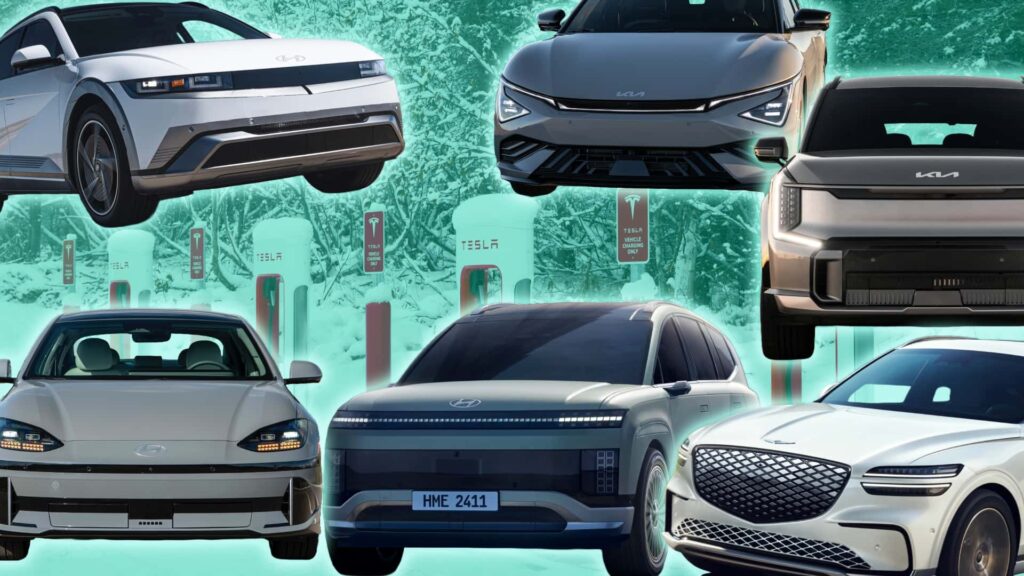- Hyundai Motor Group is racing to put Tesla’s NACS charging port in its Hyundai, Kia and Genesis electric vehicles.
- Five models going on sale soon will come equipped with the Tesla-designed port.
- Hyundai and Kia officials told InsideEVs the move was all about destroying a key barrier to EV adoption: bad charging access.
The Hyundai Motor Group has rapidly emerged as one of the biggest challengers to Tesla’s EV dominance. It’s still a distant second in terms of U.S. EV sales. But the South Korean automaker is nipping at Tesla’s heels in another way: Electric models equipped with Tesla’s charging port design, known as the North American Charging Standard (NACS).
HMG’s brands—that’s Hyundai, Kia and Genesis—are about to sell as many NACS-equipped models as Tesla itself does. It’s a signal that the auto industry-wide migration to NACS from the older standard is well underway. And HMG is leading the charge.
“A massive barrier to entry is infrastructure accessibility, so I think it was kind of an easy one to say, ‘Hey, if we’re going to do it, let’s do it quick,’” Andre Ravinowich, senior manager of product planning at Hyundai, told InsideEVs in an interview. “You see the need. You see the opportunity. It’s now available. Why wait?”

Photo by: InsideEVs
Hyundai’s brands have announced five vehicles so far that’ll come from the factory with an NACS port, with three making their debut last week at the Los Angeles Auto Show. Those are the 2025 Hyundai Ioniq 5, 2026 Hyundai Ioniq 9, 2025 Kia EV6, 2026 Kia EV9 and 2026 Genesis Electrified GV70. They’re not on the road quite yet, but will be in the coming months.
Also, from Hyundai’s past statements and photos, we can presume that an updated Ioniq 6 sedan will also use the NACS plug: “In the United States, all-new or refreshed Hyundai EVs will come exclusively with a NACS port, beginning in Q4 2024… Tesla’s commitment to expanding its network will enhance customer access to out-of-home charging and fully support the ultra-fast charging speeds on Hyundai’s advanced Electric-Global Modular Platform (E-GMP) vehicles, including Ioniq 5, Ioniq 6 and the upcoming EV models.”
Tesla sells five consumer models, all equipped with the NACS the company originated: the Model S, Model X, Model Y, Model 3 and Cybertruck. The Semi, a class-8 truck, uses a different plug. Tesla says the Cybercab, an autonomous taxi due out in 2026, won’t have a port at all. It’ll exclusively juice up through wireless, inductive charging.
With this move, the Hyundai Motor Group has beat basically the entire auto industry to the punch. While all major automakers have said they’d switch to Tesla’s plug design moving forward in exchange for access to Tesla’s vast Supercharger network, barely any have NACS-equipped models hitting roads imminently.
Historically, Superchargers were exclusively for Tesla owners, and other cars were incompatible with them from both a hardware and software perspective. Starting with Ford last year, various carmakers struck deals with Tesla to get their customers access—first through adapters, and later through NACS ports built natively into their vehicles.

Photo by: Hyundai
Hyundai Ioniq 5 and Ioniq 6 at Tesla Supercharger station in San Clemente, California
The company wanted to move quickly since access to EV charging is one of the biggest hurdles facing wider EV adoption, Kia and Hyundai officials told InsideEVs. By linking up with Tesla, owners of Hyundais and other participating brands will get access to an additional 17,000 EV charging stalls and counting.
“When it’s something that needs to be universally accessible, you’re not helping the public by having an A and a B and not allowing public access to both,” Steve Center, Kia America COO and Executive Vice President, told InsideEVs last week. “Which one should be the standard? Don’t know, don’t care. Right now there’s more of those chargers,” he said, referring to Tesla Superchargers.

Photo by: InsideEVs
Timing was also on the company’s side, the officials said. The Ioniq 9 is a brand-new model coming out next spring, while others were due for mid-cycle refreshes anyway. That presented the opportunity to switch up the charging port. In the EV6’s case, Kia also moved its charging port from the right rear to the left rear, mirroring Tesla’s setup for its cars. EVs with their ports in other places sometimes need to block multiple Supercharger stalls just to plug in, and Kia wanted to make Supercharging more convenient.
Meanwhile, other brands haven’t been as quick to roll out NACS-native cars. Ford refreshed the Mustang Mach-E crossover for the 2024 model year, so it missed the boat. General Motors launched several new EVs this year and has multiple coming soon from Cadillac, but we haven’t seen any with a native NACS port out of the gate quite yet. Porsche just started delivering its electric Macan, which also uses the old standard. Those projects were all likely deep into development when all the Tesla deals kicked off.

Photo by: Lucid Motors
Lucid Gravity with Tesla NACS charging port.
However, the Gravity, a three-row SUV from the EV startup Lucid Motors, will launch with a NACS port later this year.
HMG is all but certain to surpass Tesla in terms of NACS-equipped cars soon enough. Going forward, all of its new and refreshed EVs sold in the U.S. will come from the factory with NACS charging. So existing models like the Hyundai Ioniq 6 and Genesis GV60, along with forthcoming ones like the Kia EV3, should join the party soon.
Contact the author: tim.levin@insideevs.com

